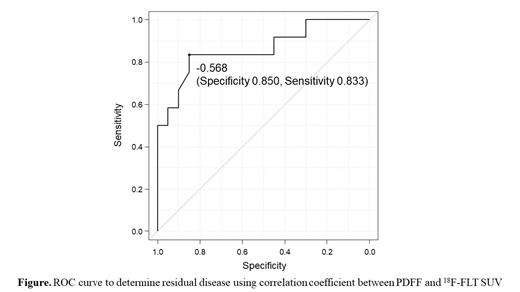Introduction
Bone marrow examination is primarily focused on a limited region of the ilium, thereby inadequately assessing systemic hematopoiesis or residual tumor cells after therapy. Magnetic resonance imaging (MRI) of the spine can examine the fat marrow, but does not provide a direct assessment of hematopoietic cells. The use of the radiopharmaceutical 3‘-deoxy-3‘- 18F-fluorothymidine ( 18F-FLT) positron emission tomography (PET), which measures nucleic acid synthesis, can provide a quantifiable means of assessing hematopoietic cell proliferation. The combination of whole-body MRI and 18F-FLT PET may provide a more accurate assessment of whole-body bone marrow hematopoiesis in hematologic malignancies.
Methods
A prospective, open-label, exploratory study (UMIN000041491) was conducted to evaluate hematopoiesis using 18F-FLT PET/MRI imaging in patients planned for allogeneic hematopoietic stem cell transplantation. Subjects were patients over 20 years of age with hematologic malignancies who underwent 18F-FLT PET/MRI imaging before transplantation and at 50 and 180 days after transplantation. After an intravenous injection of 185 MBq 18F-FLT, patients were transferred to a simultaneous 3.0 T PET/MR scanner (Signa PET/MR; GE Healthcare, Waukesha, WI). The PET acquisition was performed in 3D mode with a 5.5 min/bed position (89 slices/bed) and a 24-slice overlap in 5 to 6 beds. The percentage of fat marrow was determined using MRI proton density fat fraction (PDFF) with a 1 cm 2 region of interest at 26 sites: cervical spine (C2-C7), thoracic spine (Th1-Th12), lumbar spine (L1-L5), and superior posterior iliac spine (two sites on each side). Similarly, the standardized uptake value (SUV) of 18F-FLT was measured.
Results
Thirteen patients with hematologic malignancies (8 with acute myeloid leukemia, 2 with acute lymphoblastic leukemia, and 3 with malignant lymphoma) were evaluated between August 2020 and April 2023. The median age of the patients was 46 years (range: 23 ~ 65). Seven patients underwent cord blood transplantation, while the remainder received peripheral blood stem cell transplantation. Prior to transplantation, all 13 patients underwent 18F-FLT PET/MRI scans. After transplantation, due to treatment-related death or worsening of the primary disease, 11 patients underwent scans on day 50, while 8 patients underwent scans on day 180, resulting in a total of 32 evaluable scans. In the 28 cases in hematologic remission at imaging, mean PDFF values were higher in the iliac (63.3% ± standard deviation 13.9) and lumbar (60.4% ± 14.9) than in the thoracic (47.2% ± 17.1) and cervical (37.5% ± 14.8) spines. Conversely, mean 18F-FLT SUV was higher in the thoracic (6.98 ± 2.31) and cervical (6.82 ± 2.03) than in the lumbar (5.06 ± 2.39) and iliac (3.95 ± 1.88) spine. This site-specific disparity in PDFF and 18F-FLT SUV was consistent both before and after transplantation. In all 32 cases, the median correlation coefficient between PDFF and 18F-FLT SUV was -0.60 (range: -0.92 ~ 0.17, Pearson's cumulative correlation coefficient), and 25 cases (78.1%) had a negative correlation coefficient below -0.4. Comparing the 12 cases with residual disease (4 cases with hematologic non-remission and 8 cases with hematologic remission but abnormal G-banding or quantitative polymerase chain reaction) with the 20 cases in complete remission, the correlation between PDFF and 18F-FLT SUV was significantly weaker in the residual disease group (-0.37 vs. -0.75, p<0.001, Mann-Whitney U test). When the correlation coefficient threshold was set at -0.57, the ROC curve for determining residual disease had an AUC of 0.86, a sensitivity of 83.3%, and a specificity of 85.0%.
Discussion
It is important to understand that the fat marrow and hematopoiesis degree in the iliac bone differs from that in the thoracic and cervical spine throughout the transplantation process, thereby influencing the disease status evaluation in hematological malignancies. The correlation between PDFF and 18F-FLT SUV, which is strong in cases of remission, weakens in cases of residual disease, even at the level of minimal residual disease. This discrepancy may reflect aberrant tumorigenic cell proliferation that differs from the norm. Thus, 18F-FLT PET/MRI was useful in understanding the hematopoietic and disease state of the systemic bone marrow in patients with hematologic malignancies.
Disclosures
Hosono:Abbvie: Honoraria. Yamauchi:Nihon Kayaku: Honoraria, Research Funding; Sumitomo Pharma: Honoraria, Research Funding; Nihon Shinyaku: Honoraria, Research Funding; Astellas: Honoraria, Research Funding; Janssen Pharma: Honoraria, Research Funding; Abbvie: Honoraria, Research Funding; Chugai: Honoraria, Research Funding.


This feature is available to Subscribers Only
Sign In or Create an Account Close Modal